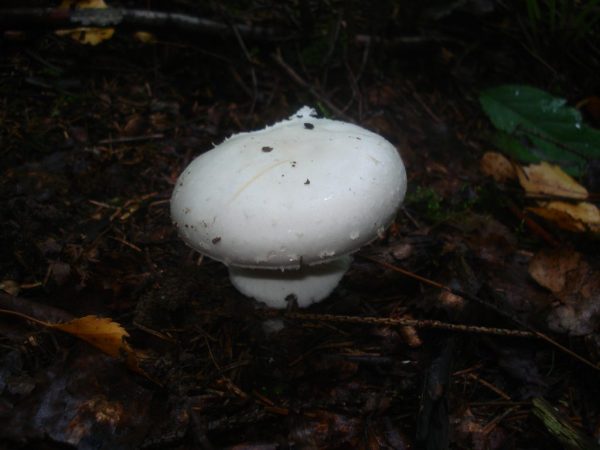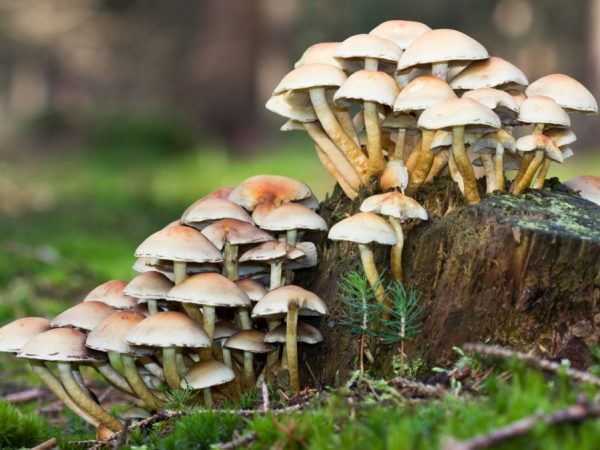Description of white toadstool
White grebe, or stinky fly agaric, is the most poisonous mushroom in the world. It is found in deciduous and coniferous forests of the temperate zone. The species bears fruit from early June to early October. The most typical neighbors of this fungus are sphagnum and pine.

Description of white toadstool
The appearance of the mushroom
At a young age, the white toadstool has an egg-shaped body. As it grows and ages, it divides into a sharply defined stem and a cap covered with a film. The upper part (cap) of the mushroom grows up to 4-16 cm in diameter. It is usually white with a slight yellowness at the top. The color of the cap can vary from white to off-white and with a pinkish tinge. The cap may be deformed. The edge of the cap is smooth, the surface is fibrous to the touch.
The flesh of the smelly fly agaric has a fleshy structure; when pressed, it does not change color. The pulp has a specific odor reminiscent of chlorine. The plates are light, loose and soft in structure, wide.
A description of a white toadstool is impossible without mentioning its leg. Amanita muscaria has a long leg up to 16 cm in length and up to 3 cm in diameter. Typical for her is a cylindrical shape with a thickened (tuberous) base, a whitish color with a moire image, and a clearly defined free Volvo with a blade division, characterized by a white color. The width of this part reaches 4-5 cm, it is immersed in the soil. Almost under the head itself there is a ring.
Spore powder, like other parts of the fungus, is pale in color. Old white fly agaric has an unpleasant odor.
For white toadstool, the formation of mycorrhiza with representatives of hard and soft tree species is characteristic.

Amanita muscaria has a long leg up to 16 cm in size
Twin mushrooms
According to the description, twins are typical for the white toadstool, found among edible and poisonous species. From edibles, green russula, float, green ryadovka and champignon are isolated, from inedible ones - toadstool-like fly agaric.
- Edible Green Russula: differs in the typical color of the upper part, dense leg. The diameter of the cap reaches 15 cm; in dry conditions, it is characterized by shine. With age, it acquires a brown color. It is easy to distinguish from a white toadstool: the russula has a different cut and there is no whitish ring on the leg.
- Champignon, or edible peppers: similar to the immature fruiting bodies of the stinking fly agaric. Its cap usually does not exceed 8-9 cm in diameter, is white-colored, has scaly, dry and non-mucous to the touch.
- Row green: in representatives of the species, the cap is dense, growing up to 12 cm in diameter. In mature specimens, the upper part is raised, the integumentary tissue is smooth. This mushroom is often confused with a poisonous one, however, the toadstool has white plates, and greenfinches are green or yellow. The leg at the row is shortened.
- Float: it is classified as a fly agaric, it is better to be careful when collecting it, since both the fly agaric and some other representative are disguised as it. The edges of the cap are uneven. The mushroom is odorless.The edible representatives do not have a ring on the stem.
- Amanita muscaria: looks like a smelly fly agaric. It has a thick cap - up to 13 cm in diameter. It is easy to confuse it with a white toadstool due to the similar color of the cap. Plates and spore powder are white in color.
Application in medicine
The mushroom contains a huge amount of poison that destroys internal organs. The danger of poisoning with a white toadstool is many times greater than its potential beneficial properties.
- Homeopathic (i.e. highly diluted) doses of these poisons can act as an antidote to other dangerous fungi, as well as for many diseases: gastritis, cholera, diphtheria, cephalgia (headaches), vertigo (dizziness), visual disturbances, etc. ...
- A destructive effect is found on harmful arthropods, which are deliberately poisoned with poison without harming others.
- In the field of cosmetology, the possibility of using microinjections to combat pallor and age-related aging of the skin, the appearance of wrinkles is being considered.
- Experiments on laboratory rats indicate that tinctures based on this fungus can be used to treat cancer.

The mushroom contains a huge amount of poison
White toadstool poisoning
Poisoning with a white toadstool, or stinking fly agaric, is characterized by several stages of development. This pathology manifests itself only after a day or two, since by this time the mucous membrane of the intestinal tract is affected, which provokes acute pain, diarrhea and nausea, followed by vomiting. The next stage of poisoning involves an apparent improvement in the condition, but at this time the disease does not subside. At the final stage, problems with the kidneys and liver are most acute, which is why the person soon dies.
If the following symptoms of poisoning occur, it is imperative to immediately contact a medical institution: vomiting, intestinal colic, abdominal pain, thirst, diarrhea with bloody discharge, pallor, convulsions, low body temperature, muscle pain, deterioration of visual activity, weak pulse.
Irina Selyutina (Biologist):
White toadstool is as deadly mushroom as pale toadstool. In the fruiting bodies of the stinking fly agaric, in addition to amatoxins and phallotoxins, the toxin virosine is also present. 1 kg of fresh fruit bodies of this mushroom contains 0.25 g of virosine. The most toxic are the volva and the pulp of the cap, but in the plates and the leg of the fruiting body of the toxin contains less. As for the pale toadstool, in the case of the stinking fly agaric, it is recommended to touch it with your hands in the forest and not put it in a basket with previously collected edible mushrooms in order to avoid their poisoning.
To save the victim, 4 categories of treatment are used:
- preliminary medical assistance;
- medical support measures;
- special medical procedures;
- liver transplant.
Unfortunately, very often the only way to save a person's life is liver transplantation.
To provide first aid to the victim, the stomach is washed with boiled water with salt or potassium permanganate. Also, do not forget about the action of activated carbon. The invaluable help of milk thistle has been proven. To make an antidote, a teaspoon of herbs is poured with boiling water, steamed for half an hour, insisted with further filtering and given to the patient three times a day, a third of a glass.
Conclusion
Amanita muscaria is the most poisonous and therefore the most dangerous mushroom in the world. It is banned for use, even though its useful properties have not yet been fully confirmed. The use in homeopathic treatment is carried out exclusively under the supervision of medical professionals. With the timely detection of symptoms of poisoning, it is necessary to call an ambulance and provide primary first aid, so that the victim can overcome the disease. It is impossible to be inactive, since a person can die quickly.



